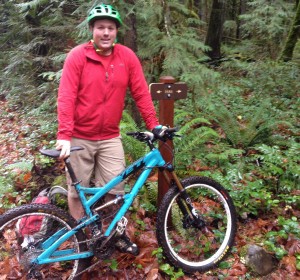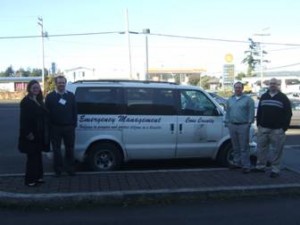 As an a civil engineer, I was lucky enough to see many of the projects I worked on come into fruition, as construction was generally a year or two after design. In planning, we often don’t get the opportunity, as many plans we write are long term and implemented over the course of 10, 20 or 40 years. Last week, I had the opportunity to present the Coos County Emergency Management Strategic Plan to the Coos County Commissioners in Coquille, Oregon. Having been involved with the Douglas and Coos County Strategic Emergency Management Plans project since the beginning, it was especially exciting for me to see it through to completion and receive feedback from the elected officials that have ultimate authority over the plan.
As an a civil engineer, I was lucky enough to see many of the projects I worked on come into fruition, as construction was generally a year or two after design. In planning, we often don’t get the opportunity, as many plans we write are long term and implemented over the course of 10, 20 or 40 years. Last week, I had the opportunity to present the Coos County Emergency Management Strategic Plan to the Coos County Commissioners in Coquille, Oregon. Having been involved with the Douglas and Coos County Strategic Emergency Management Plans project since the beginning, it was especially exciting for me to see it through to completion and receive feedback from the elected officials that have ultimate authority over the plan.
I first began work on the project in January of 2013, as part of my Community Planning Workshop (CPW) project. Looking to expand my knowledge of emergency management, the project worked with both Douglas and Coos County Emergency Management Departments. In the age of reduced funding across all levels of government, emergency management departments are constantly being asked to do more, with less. Using steering committees, stakeholder interviews, and targeted surveys, we asked three important questions:
1) How is the organization performing today?
2) What are their strengths and weaknesses?
3) What priorities should be set for the next five years?
These three questions helped us prepare a strategic plan, which is a process used to set priorities and define a path to achieve them, for each county. While popular in the business sector, they are starting to become more prevalent in the public sector. The project also included the development of a regional plan, which outlined how the two emergency management departments can work together towards common goals. This was the first time a regional plan had been prepared for county level emergency management in Oregon, so a lessons learned document was also prepared for other counties across the state to use. In the end, Douglas and Coos County have a roadmap for the next five years on where to focus their time and energy, in addition to collaborative opportunities that further both of their goals.
After experiencing the devastation of Tropical Storm Irene during my time at the Vermont Agency of Transportation, I became especially aware of the role emergency management plays in mitigating, preparing, responding and recovering from disasters of all kinds. As a planner with a background in civil engineering, the interdependencies within the emergency management field are countless. Community Planning Workshop (a program of the Community Service Center, University of Oregon) gave me a unique chance to combine both sets of skills to help small communities in Oregon and address a facet of both professions: serving the public for the greater good.
 About the Author: Nicholas S. Meltzer, P.E., is a project coordinator for Community Planning Workshop (CPW) and in his second year of obtaining a Masters in Community and Regional Planning. A reformed engineer, Nick spent 26 years in New England before embarking on a professional and personal journey to Oregon. In addition to balancing class and project managing, he makes sure to enjoy the plethora of mountain biking trails and micro-brews available across the state.
About the Author: Nicholas S. Meltzer, P.E., is a project coordinator for Community Planning Workshop (CPW) and in his second year of obtaining a Masters in Community and Regional Planning. A reformed engineer, Nick spent 26 years in New England before embarking on a professional and personal journey to Oregon. In addition to balancing class and project managing, he makes sure to enjoy the plethora of mountain biking trails and micro-brews available across the state.
